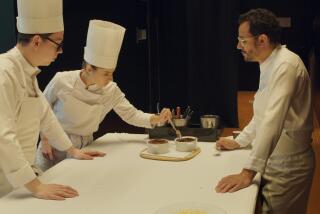Under Wraps
- Share via
“I know what you’re thinking,” says Ludovic Lefebvre, chef de cuisine at L’Orangerie, as he unfurls a sleeve of plastic from the restaurant’s vacuum sealer. Into it go a chunk of ahi, a pat of butter and a teaspoon of ground vanilla. “You cook this in plastic! How can it be any good? But just wait.” Whoosh goes the vacuum sealer, sucking the air from the pouch to create a neat package ready for cooking.
Indeed, any sort of cooking technique that involves vacuums and plastic wrap is likely to astral-project most of us into the frozen foods section of Albertsons. But don’t put your head in the microwave just yet. Although still fairly uncommon stateside, the sous vide method, which translated literally from the French means “under vacuum,” has for several years been widely used by Europe’s top chefs and shows every sign of becoming the next culinary rage. According to Lefebvre, the technique was pioneered in France about 15 years ago. Lefebvre, in fact, learned the ropes from mentor and acclaimed chef Pierre Gagnaire.
Moments earlier, Lefebvre had flash-seared four pieces of ahi in olive oil before combining them with the other ingredients. Once sealed, each packet is placed for several minutes in water that has been heated to 140 degrees. The result: soft-cooked ahi in a light sauce redolent of vanilla--and a favorite at the restaurant. Lefebvre insists sous vide is not new to the realm of traditional French cooking, but the modern version of a centuries-old technique by which meat, vegetables and spices were enclosed in the bladder of a cow or lamb and plunged into hot water for cooking.
It’s worth mentioning that for the home chef, vacuum sealers aren’t the extravagance they once were. Sur La Table in Santa Monica, for example, sells them for $280, and with considerably cheaper models available at restaurant supply stores and online, sticker shock doesn’t have to be an issue. They’re also excellent for preserving food, both cooked and fresh.
The sous vide method itself is a snap. Prep work is minimal, cooking time ephemeral and the results elegant. The vacuum sealing not only intensifies and melds flavors, but preserves nutrients, particularly in vegetables, that would otherwise leach into the hot water. The technique may not be entirely idiot-proof, but it can be easily mastered by a minimally competent home cook. “The great thing about sous vide is you can experiment with all kinds of combinations and spices,” says Lefebvre. Indeed, the variations seem endless. One of the chef’s favorite recipes combines carrots and a splash of orange juice--cooking time is about 12 minutes--a nice side dish that plays the citrus flavor against the sweetness of the carrots.
Of course, should you mount a sous vide dinner party, you may have to educate your guests. Lefebvre himself, who became head chef of L’Orangerie four years ago at the age of 24, initially met with more than a little skepticism. “When I told my boss we needed a vacuum sealer, he thought I was crazy,” says the French-born chef. “Then I made him a sous vide dish and he said, ‘unbelievable.’ ”
And if you still can’t convince your dinner guests that you know what you’re doing, just tell them you ran out of sheep bladders.
Ludovic Lefebvre’s Cinnamon and Rosemary-Infused Chicken Breast with Baby Vegetables
Serves 4
4 chicken breasts, skinned and boned
1 teaspoon butter
2 cups chicken stock
1 cup veal demi-glace
1 cup verjuice
16 baby carrots, peeled
16 baby turnips, peeled
4 sprigs fresh rosemary
4 sprigs fresh lemon thyme
3 sticks cinnamon
Salt and white pepper, to taste
*
Combine ingredients in a large sous vide bag. Vacuum seal and poach bag in 140- degree water for 40 minutes. Open pouch and pour liquid into sauce pot. Reduce liquid by one-quarter, adding salt and pepper to taste. Put chicken breasts in covered casserole dish and cook in oven at 350 degrees for 10 minutes. Arrange chicken breasts and vegetables on plate and pour sauce over them before serving.
More to Read
Eat your way across L.A.
Get our weekly Tasting Notes newsletter for reviews, news and more.
You may occasionally receive promotional content from the Los Angeles Times.










